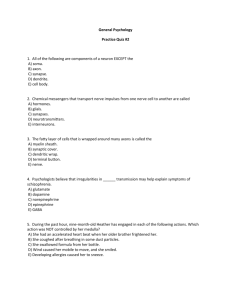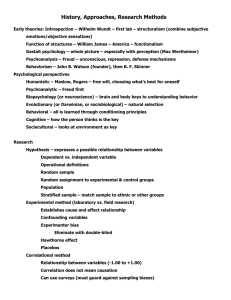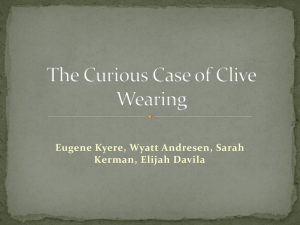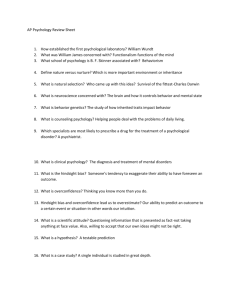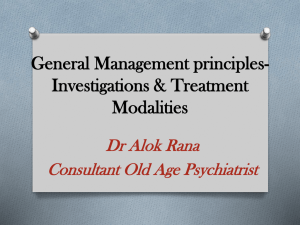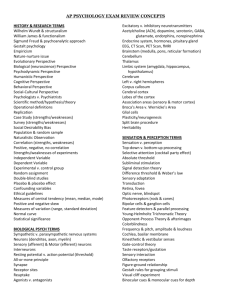Similarity/Review Activity
advertisement
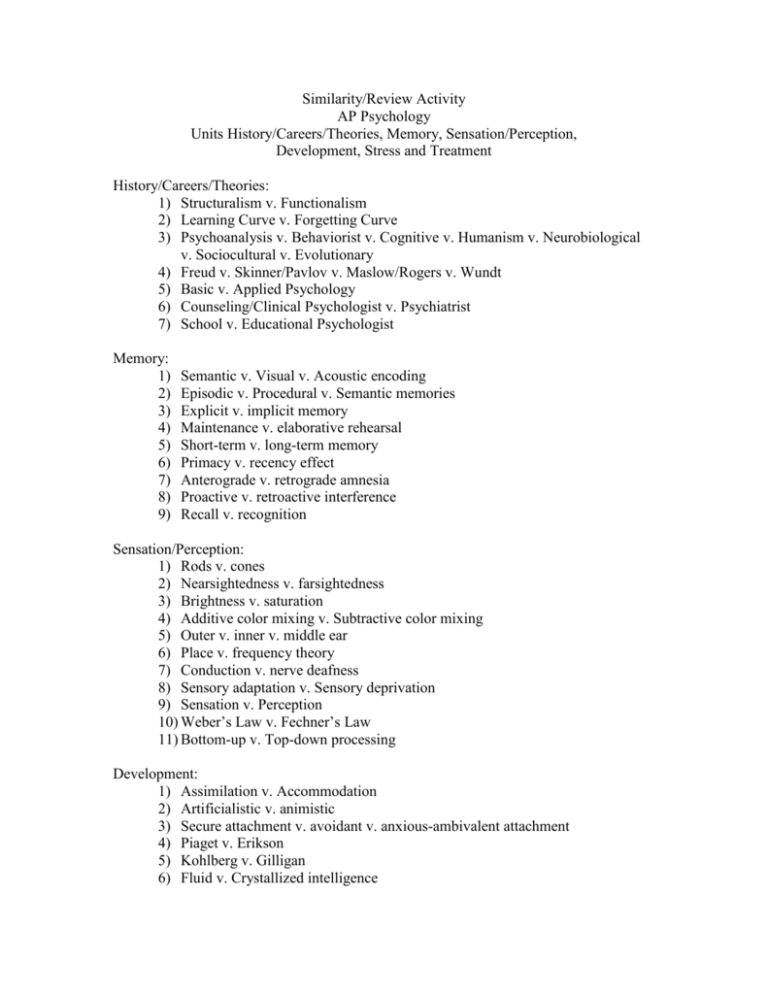
Similarity/Review Activity AP Psychology Units History/Careers/Theories, Memory, Sensation/Perception, Development, Stress and Treatment History/Careers/Theories: 1) Structuralism v. Functionalism 2) Learning Curve v. Forgetting Curve 3) Psychoanalysis v. Behaviorist v. Cognitive v. Humanism v. Neurobiological v. Sociocultural v. Evolutionary 4) Freud v. Skinner/Pavlov v. Maslow/Rogers v. Wundt 5) Basic v. Applied Psychology 6) Counseling/Clinical Psychologist v. Psychiatrist 7) School v. Educational Psychologist Memory: 1) 2) 3) 4) 5) 6) 7) 8) 9) Semantic v. Visual v. Acoustic encoding Episodic v. Procedural v. Semantic memories Explicit v. implicit memory Maintenance v. elaborative rehearsal Short-term v. long-term memory Primacy v. recency effect Anterograde v. retrograde amnesia Proactive v. retroactive interference Recall v. recognition Sensation/Perception: 1) Rods v. cones 2) Nearsightedness v. farsightedness 3) Brightness v. saturation 4) Additive color mixing v. Subtractive color mixing 5) Outer v. inner v. middle ear 6) Place v. frequency theory 7) Conduction v. nerve deafness 8) Sensory adaptation v. Sensory deprivation 9) Sensation v. Perception 10) Weber’s Law v. Fechner’s Law 11) Bottom-up v. Top-down processing Development: 1) Assimilation v. Accommodation 2) Artificialistic v. animistic 3) Secure attachment v. avoidant v. anxious-ambivalent attachment 4) Piaget v. Erikson 5) Kohlberg v. Gilligan 6) Fluid v. Crystallized intelligence Stress: 1) 2) 3) 4) GAS v. Fight or flight Selye v. Cannon Eustress v. Distress Type A v. Type B Treatment: 1) Psychodynamic Theory v. Behavioral Theory v. Cognitive(Ellis) Theory v. Humanistic(Rogers) Theory 2) Systematic Desensitization v. Flooding 3) Antipsychotics Clorazil v. Clozapine v. Thorazine 4) Antianxiety Valium v. Librium 5) Antidepressants Prozac v. Lithium v. Valium 6) ECT v. Frontal Lobotomy Research/Statistics: 1) Independent v. Dependent v. Confounding Variable 2) Naturalistic observation v. Case Study 3) Experiment v. Correlation 4) Experimental Group v. Control Group 5) Random assignment v. Random selection 6) Single blind v. double blind 7) Median v. Mode 8) Range v. Standard Deviation 9) Negative correlation v. Positive Correlation 10) Positive v. Negative Skew Consciousness: 1) Conscious v. preconscious 2) Priming v. subliminal perception 3) Anterograde amnesia v. retrograde amnesia 4) Stage one sleep v. stage two sleep 5) Stage four sleep v. REM sleep 6) Nightmare v. night terror 7) Insomnia v. sleep apnea 8) Wish fulfillment v. activation synthesis 9) Posthypnotic suggestion v. post hypnotic amnesia 10) State theory v. role theory 11) Psychological dependence v. physical dependence 12) Barbiturates v. alcohol 13) Stimulants v. opiates Intelligence: 1) IQ v. EQ 2) Stanford-Binet v. WAIS 3) Aptitude v. Achievement Test 4) Test retest reliability v. alternate forms reliability 5) Content validity v. criterion validity 6) Sternberg v. Goleman 7) Fluid v. Crystallized 8) Spearman v. Gardner 9) Divergent v. convergent thinking Motivation and Emotion: 1) Instinct theory v. Drive theory 2) Arousal theory v. incentive theory 3) Hunger v. Satiety 4) Glucose v. Insulin 5) Lateral hypothalamus. Ventromedial hypothalamus 6) Anorexia v. Bulimia 7) Estrogen v. Androgen 8) Intrinsic v. Extrinsic motivation 9) Subjective well being v. feel good do good phenomenon 10) Sympathetic nervous system v. Parasympathetic nervous system 11) James Lange v. Cannon Bard 12) Primary Emotions v. Secondary Emotions Mental Illness: 1) Changes from DSM-IV-TR to DSM-5 . Another helpful link: The DSM 5 2) Generalized Anxiety Disorder v. Phobia 3) Conversion Disorder v. Illness anxiety disorder 4) Dissociative Identity Disorder v. Schizophrenia 5) DID v. Fugue 6) Major Depressive Disorder v. Dysthymic Disorder 7) Hallucination v. Delusion 8) Positive Symptoms of Schizophrenia v. Negative Symptoms of Schizophrenia 9. Histrionic v. Narcissistic 10. Avoidant v. Antisocial 11. Borderline v. Dependent 12. Flooding Therapy v. Systematic Desensitization Social Psychology: 1) Groupthink v. Group Polarization 2) Social facilitation v. Social interference 3) Asch v. Milgram v. Zimbardo 4) Prisoner’s Dilemma v. Commoner’s Dilemma 5) Stereotype v. Prejudice v. Discrimination 6) Central Route v. Peripheral Route to Persuasion 7) Door-in-the-face v. Foot-in-the-door 8) Self-fulfilling Prophecy v. Self-handicapping Strategy 9) Fundamental Attribution Error v. Actor Observer Effect 10) Confirmation Bias v. Hindsight Bias Personality: 1) Jung v. Horney v. Freud v. Adler 2) Displacement v. Sublimation 3) Denial v. Repression Cognition v. Language 1) Availability Heuristic v. Representative Heuristic 2) Whorf v. Skinner v. Chompsky 3) Grammar v. Syntax Learning: 1) 2) 3) 4) 5) 6) 7) Classical Conditioning v. Operant Conditioning Negative Reinforcement v. Positive Reinforcement Variable-interval schedule v. variable-ration schedule Stimulus Discrimination v. Stimulus Generalization Extinction v. Spontaneous Recovery Positive Punishment v. Negative Punishment Shaping v. Chaining Brain: 1) 2) 3) 4) 5) 6) 7) 8) Resting Potential v. Action Potential Sensory Neurons v. Motor Neurons Sympathetic Nervous System v. Parasympathetic Nervous System Excitatory Response v. Inhibitory Response Reticular Activating System v. Pons Broca’s Area v. Wernicke’s Area Sensory Strip v. Motor Strip Basal Ganglia v. Cerebellum

